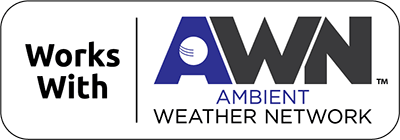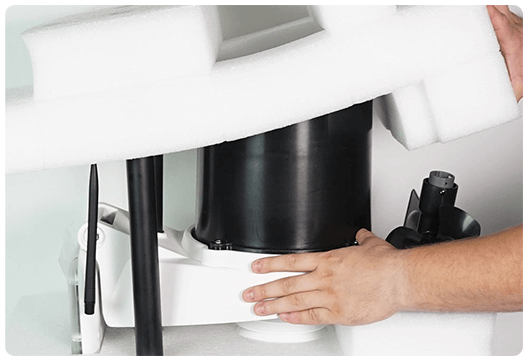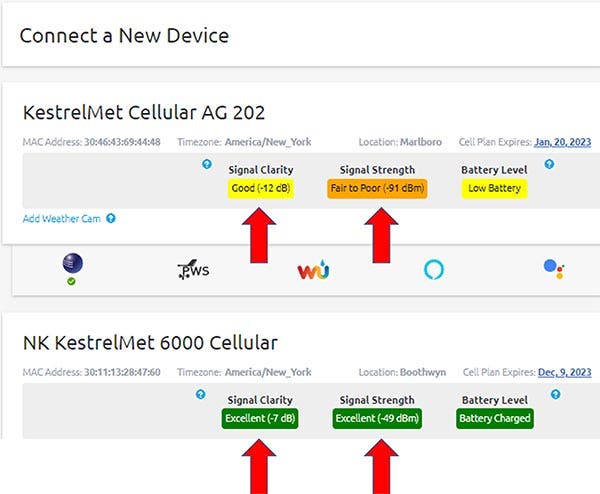KestrelMet 6000 AG Weather Station
The KestrelMet 6000 AG Weather Station is an onsite monitoring solution for today's growers who want comprehensive crop and field data without the higher cost and complication of other options available.
The KestrelMet 6000 AG is a game-changing agricultural tool that makes weather monitoring and data management simpler and more affordable for farmers. With reliable, accurate data from the KestrelMet, farmers can make informed decisions for improving crop, irrigation, and pest management strategies.


The KestrelMet 6000 AG can be customized by adding sensors for monitoring soil moisture, soil temperature, leaf wetness, and solar irradiance.
The soil sensor array measures soil moisture and temperature conditions at three depths, providing reliable profile data that corresponds to the entire root zone, allowing the grower to optimize irrigation strategies.
Leaf wetness and solar irradiance sensors provide precise crop and environmental information to ensure the most effective integrated pest management program.
Contact us to discuss customized solutions for your needs.
INCREASE EFFICIENCY & PRODUCE MORE WITH LESS
We believe in simple, comprehensive weather stations that are affordable, easy to deploy, and require minimal decision-making. The KestrelMet 6000 AG is the most cost-effective and easy-to-use professional-grade weather station available, so that you can produce more with less.
The KestrelMet 6000 is a complete solution from the start, with easy access to data online and add-on sensors available to meet the needs of growers and precision farming operations. Equipped with accurate, pre-configured sensors, a high-power photovoltaic panel, a backup battery, and intelligent power management— the KestrelMet 6000 eliminates the hassle of cables, wiring, and connecting to an external power source. Optimize production on a field-by-field basis with live, continuous data from exactly where your crops are growing.
Choose cellular or Wi-Fi communication for data transmission based on your agriculture operation needs.
Measurements
- Temperature
- Relative Humidity
- Wind Speed
- Wind Direction
- Dewpoint
- Barometric Pressure
- Rainfall
- Leaf Wetness (optional)
- Solar Irradiance (optional)
- Soil Temperature and Moisture Sensors (optional)
Features
- Full suite of meteorological measurements
- Add-on sensors for leaf wetness, solar irradiance, and soil sensor array - soil moisture and soil temperature (3 different depths)
- All-in-one design for a quick and straightforward setup
- Integrated Cellular modem with cloud connected data plan for under $100/year
- Intelligent Power Management ensures reliable reporting even in short day and cloudy conditions
- High-power photovoltaic panel
- 24-hr aspirated fan for maximum accuracy
- Highly visible LED status lights
- Telescoping wind sensor mast
- Choose from cellular or Wi-Fi communication
- Cellular Station — Integrated Cellular modem with cloud-connected low-cost data plan for less than $10 per month; FREE first 3 month subscription
- Wi-Fi Station — Conveniently connect the KestrelMet through your Wi-Fi network within a distance of up to 1000 feet line of sight
ALL-IN-ONE DESIGN WITH WITH ADD-ON ENVIRONMENTAL SENSORS
The KestrelMet 6000 is an all-in-one station with a one-click ordering experience. You no longer have to rely on regional meteorological measurements to manage your systems, schedules, or software. Instead, with site-specific information based on your specific crop, soil, and field conditions, you can improve agricultural management decisions to maximize efficiency and yields while reducing waste and costs. The KestrelMet 6000 AG measures your onsite farm conditions and provides you with the exact data needed to make the right decision at the right time saving you time, resources, and unnecessary expenses.
Optional sensors available:
Leaf Wetness:
The leaf wetness sensor determines the amount of time a leaf's surface is wet and dry. Perfect for vineyards and orchards, this sensor is key in managing irrigation and protecting plants from fungal diseases early on.
Solar Irradiance:
The solar irradiance sensor helps optimize plant growth and crop placement strategy.
Soil Moisture and Temperature Sensor:
Choose to add the soil sensor array and monitor precise soil measurements at three different depths.

DATA INTEGRATION
The KestrelMet 6000 is an all-in-one, self-powered weather station that integrates easily into data-driven technology using a cloud-based API.
Our API offers integration, personalization, and automation advantages.
- Share and embed our API weather data into your own platform for a personalized solution that fully leverages your existing technology investments.
- Save time and money with seamless integration and information delivery from our API to your platform via the cloud.
- API data feeds from our high-performance weather station into selected programs so you can visualize field-level and crop-specific insights at a glance for the most informed, real-time decision-making.
Contact us to discuss Data Integrations
SIMPLE SETUP AND UPGRADES
We believe ordering your station should be just as easy as installing, operating, and maintaining it. The simple design and wireless technology allow for quick deployment and over-the-air upgrades. In addition, the KestrelMet is field-upgradeable, ensuring zero downtime and the ability to go from box to field in minutes.
Step 1
Register at AmbientWeather.net

Create an online account and connect your device online.
Step 2
Set Up Your Weather Station

Quickly assemble and easily install your KestrelMet 6000.
Step 3
View and Manage Your KestrelMet Weather Data

Access your weather data from anywhere on a laptop or mobile.
Low-Cost Cellular Plan
The KestrelMet 6000 Cellular Weather Station comes with a cloud-connected data plan from Verizon or AT&T for under $100/year, with the first 3 months of data completely FREE. Add in a long service life with continuous reliable operation, and the powerfully capable KestrelMet 6000 AG emerges as the clear winner for value and performance when compared to other leading farm weather stations.









 ...
...







